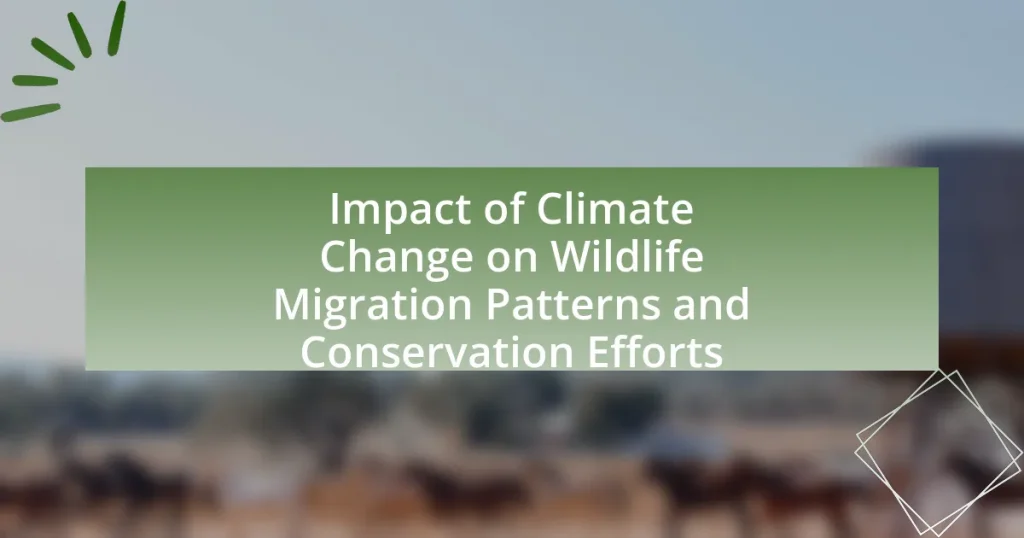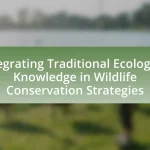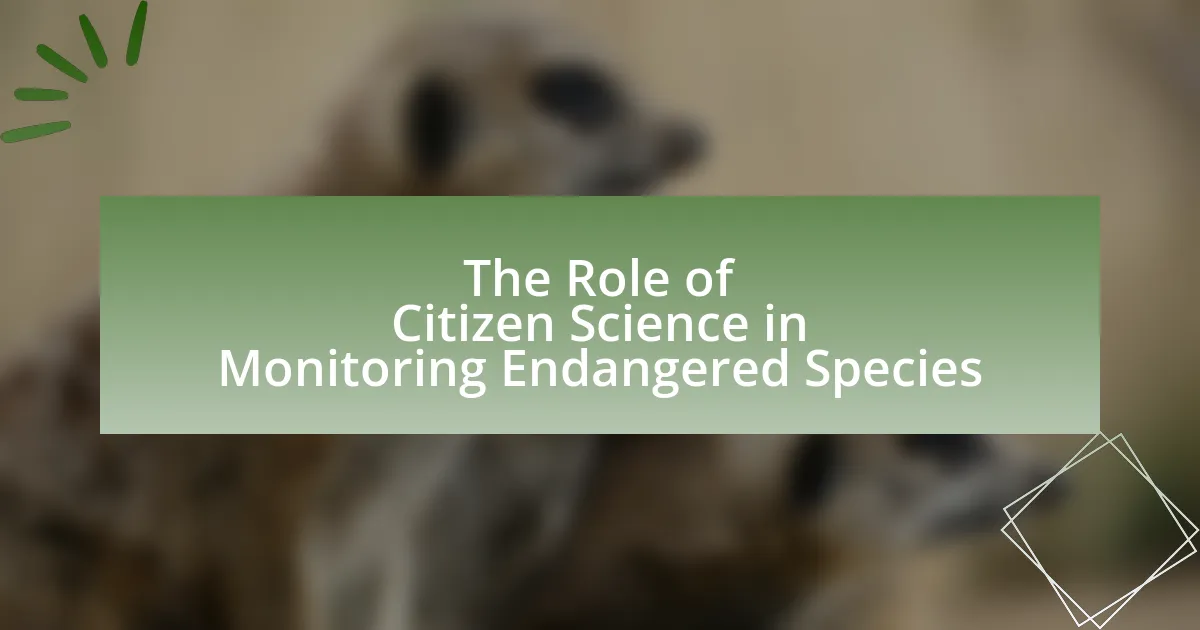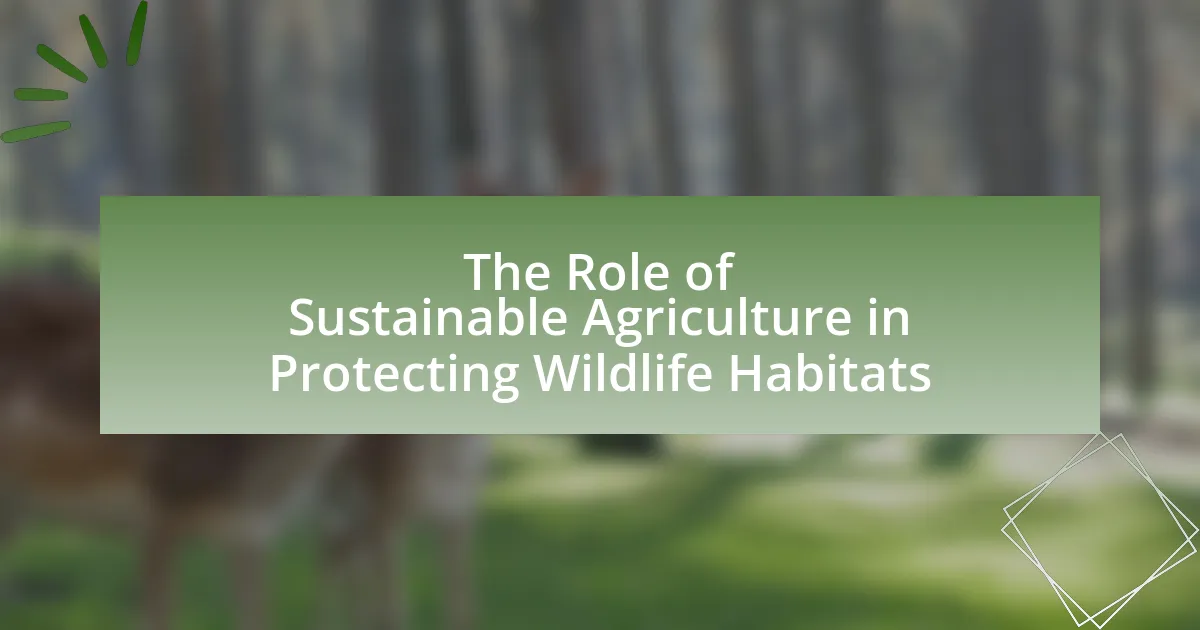The article examines the impact of climate change on wildlife migration patterns and the associated conservation efforts. It highlights how rising temperatures and altered weather patterns are shifting the timing and routes of animal migrations, affecting species such as migratory birds and marine life. Key factors influencing these changes include food availability, habitat loss, and breeding success, which ultimately threaten biodiversity and ecosystem stability. The article also discusses various conservation strategies, including habitat restoration and the establishment of wildlife corridors, as well as the importance of collaborative efforts and community-based initiatives in addressing these challenges.

What is the impact of climate change on wildlife migration patterns?
Climate change significantly alters wildlife migration patterns by shifting the timing and routes of animal movements. As temperatures rise and weather patterns change, many species are migrating earlier in the year or to new areas that were previously unsuitable for their survival. For instance, studies have shown that migratory birds in North America are arriving at breeding grounds up to 20 days earlier than they did a few decades ago, largely due to warmer spring temperatures. Additionally, marine species, such as fish, are moving toward cooler waters, which can disrupt existing ecosystems and food webs. These changes are documented in research published in the journal “Nature Climate Change,” which highlights the correlation between climate variables and altered migration behaviors across various species.
How does climate change alter migration routes for wildlife?
Climate change alters migration routes for wildlife by shifting the availability of food, breeding grounds, and suitable habitats. As temperatures rise and weather patterns change, many species are forced to move to new areas that provide the necessary resources for survival. For instance, studies have shown that migratory birds are arriving at their breeding grounds earlier due to warmer spring temperatures, which disrupts their traditional migration schedules. Additionally, the melting of polar ice caps is pushing species like polar bears further north in search of stable ice platforms for hunting. These changes in migration patterns can lead to mismatches in predator-prey relationships and affect biodiversity, as species may not adapt quickly enough to the new conditions.
What specific factors of climate change influence these alterations?
Rising temperatures, altered precipitation patterns, and increased frequency of extreme weather events are specific factors of climate change that influence alterations in wildlife migration patterns. These factors affect the availability of food and habitat, forcing species to adapt their migration routes and timings. For instance, studies show that many bird species are migrating earlier in the spring due to increased temperatures, which can disrupt their breeding cycles and food availability. Additionally, changes in precipitation can lead to habitat loss, further impacting migration patterns.
How do changes in temperature and weather patterns affect migration timing?
Changes in temperature and weather patterns significantly affect migration timing by altering the availability of food resources and suitable habitats. For instance, many bird species rely on specific temperature cues to initiate migration; warmer temperatures can lead to earlier springs, causing birds to migrate sooner than usual. Research published in the journal “Ecology Letters” by Both et al. (2004) indicates that the timing of migration for certain species has shifted by an average of 2.5 days earlier per decade due to climate change. Additionally, changes in precipitation patterns can disrupt the synchronization between migratory species and their food sources, further impacting their survival and reproductive success.
Why are wildlife migration patterns important for ecosystems?
Wildlife migration patterns are crucial for ecosystems because they facilitate nutrient cycling, species interactions, and genetic diversity. These patterns enable animals to access seasonal resources, such as food and breeding grounds, which supports population stability and ecosystem health. For instance, migratory species like wildebeest contribute to nutrient distribution across vast landscapes, enhancing soil fertility and promoting plant growth. Additionally, migration helps maintain ecological balance by connecting different habitats, allowing for the exchange of genetic material among populations, which is vital for resilience against environmental changes.
What roles do migratory species play in their ecosystems?
Migratory species play crucial roles in their ecosystems by facilitating nutrient cycling, maintaining food web dynamics, and supporting biodiversity. For instance, migratory birds contribute to seed dispersal and pollination, which are essential for plant reproduction and ecosystem health. Additionally, species such as salmon transport nutrients from marine to freshwater environments, enriching the ecosystems they inhabit. Research indicates that the decline of migratory species can lead to significant disruptions in these ecological processes, highlighting their importance in maintaining ecosystem balance and resilience.
How does disruption of migration patterns affect biodiversity?
Disruption of migration patterns negatively affects biodiversity by altering species interactions and ecosystem dynamics. When migratory species, such as birds and fish, are unable to follow their traditional routes due to climate change or habitat loss, it can lead to mismatches in timing for breeding, feeding, and pollination. For example, the decline of migratory birds has been linked to reduced seed dispersal and plant reproduction, which can diminish plant diversity. Additionally, disrupted migration can result in population declines for species that rely on specific habitats during migration, leading to decreased genetic diversity and increased vulnerability to extinction. Studies have shown that changes in migration patterns can lead to cascading effects throughout ecosystems, ultimately threatening overall biodiversity.
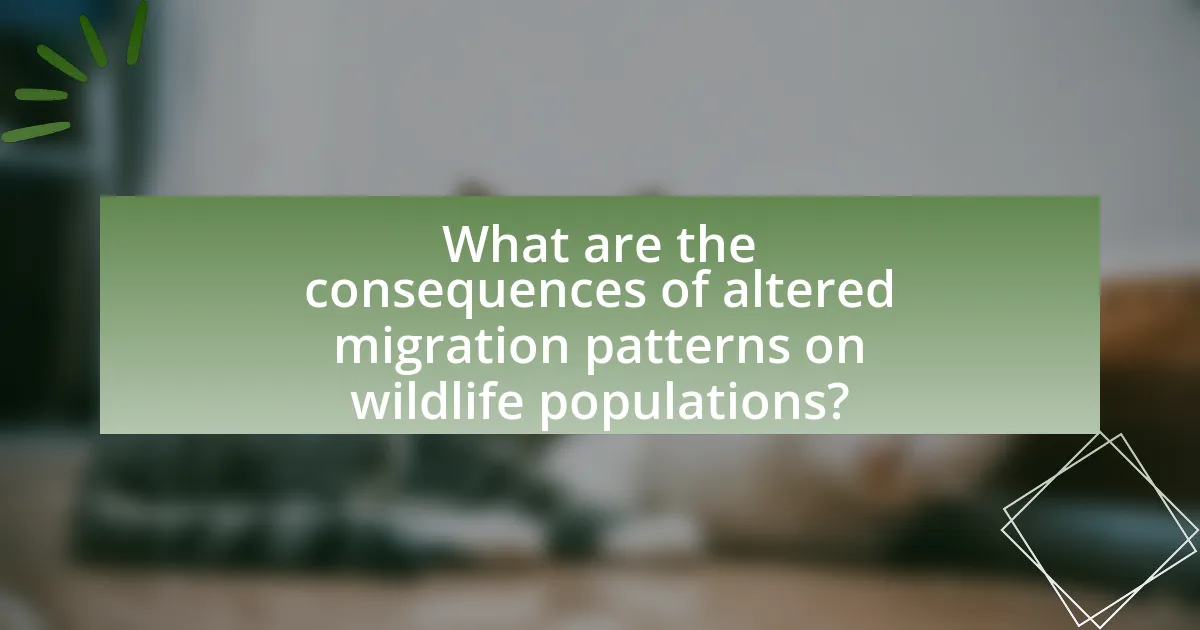
What are the consequences of altered migration patterns on wildlife populations?
Altered migration patterns significantly disrupt wildlife populations by affecting their breeding, feeding, and survival rates. For instance, species that rely on specific seasonal cues for migration may arrive at breeding grounds too early or too late, leading to mismatches with food availability. Research indicates that migratory birds, such as the American Robin, have experienced shifts in migration timing due to climate change, resulting in decreased reproductive success as they may miss peak insect availability. Additionally, altered migration routes can lead to increased competition for resources and habitat loss, further threatening population stability. Studies show that species like the Monarch Butterfly are facing declines due to changes in their migratory pathways, which are critical for their lifecycle. These consequences highlight the intricate relationship between migration patterns and wildlife population dynamics, emphasizing the need for conservation efforts to address these challenges.
How do changes in food availability impact wildlife during migration?
Changes in food availability significantly impact wildlife during migration by altering their migration routes, timing, and survival rates. For instance, when food sources become scarce due to climate change, animals may arrive at their breeding grounds too early or too late, leading to mismatches with the availability of resources necessary for reproduction and survival. Research indicates that species such as the Arctic Tern have experienced shifts in their migratory patterns in response to changing prey availability, which can affect their reproductive success. Additionally, studies show that migratory birds rely on specific food sources at critical stopover sites; if these resources are diminished, it can lead to increased mortality rates during migration.
What are the effects of habitat loss on migratory species?
Habitat loss significantly disrupts migratory species by reducing their breeding, feeding, and resting areas. This disruption leads to decreased population sizes, as species struggle to find suitable habitats for reproduction and sustenance. For instance, studies indicate that migratory birds have experienced population declines of up to 70% in regions where habitat loss is prevalent, primarily due to urbanization and agricultural expansion. Furthermore, habitat fragmentation can hinder migratory routes, making it difficult for species to reach critical areas necessary for their life cycles. This ultimately threatens biodiversity and ecosystem stability, as migratory species play essential roles in pollination, seed dispersal, and nutrient cycling.
How does climate change affect breeding success in migratory animals?
Climate change negatively affects breeding success in migratory animals by altering their habitats and food availability. As temperatures rise and weather patterns shift, migratory species may arrive at breeding grounds too early or too late, leading to mismatches with food resources critical for raising young. For instance, studies have shown that changes in the timing of flowering plants can disrupt the synchronization between migratory birds and their food supply, resulting in lower chick survival rates. Additionally, habitat loss due to climate change can reduce suitable breeding sites, further impacting reproductive success.
What are the long-term implications for species survival?
Long-term implications for species survival include increased extinction rates due to habitat loss and altered migration patterns caused by climate change. As temperatures rise and weather patterns shift, many species struggle to adapt, leading to population declines. For instance, a study published in “Nature Climate Change” by Parmesan and Yohe (2003) found that 50% of species studied showed shifts in their geographic ranges, often moving towards cooler areas. This disruption can result in mismatches between species and their food sources or breeding grounds, further threatening their survival. Additionally, fragmented habitats due to human activities exacerbate these challenges, limiting species’ ability to migrate and adapt.
Which species are most at risk due to changing migration patterns?
Bird species such as the Arctic Tern and the Red Knot are most at risk due to changing migration patterns. These species rely on specific migratory routes and timing that are being disrupted by climate change, leading to mismatches in food availability and breeding success. For instance, the Arctic Tern migrates from the Arctic to the Antarctic, and changes in sea ice and temperature can affect its feeding grounds. Similarly, the Red Knot depends on the availability of horseshoe crab eggs along its migratory route, which are also impacted by climate change. Studies indicate that these disruptions can lead to population declines, highlighting the urgent need for conservation efforts to address these challenges.
How can we predict future trends in wildlife populations?
Future trends in wildlife populations can be predicted through the analysis of ecological data, modeling techniques, and monitoring of environmental changes. Ecologists utilize statistical models, such as population viability analysis and species distribution models, to forecast how species will respond to factors like climate change, habitat loss, and human activity. For instance, a study published in “Ecology Letters” by Keith et al. (2008) demonstrated that integrating climate models with species distribution data can effectively project shifts in wildlife populations due to changing temperatures and precipitation patterns. Additionally, long-term monitoring programs, such as the North American Breeding Bird Survey, provide critical data that help identify trends and inform conservation strategies.
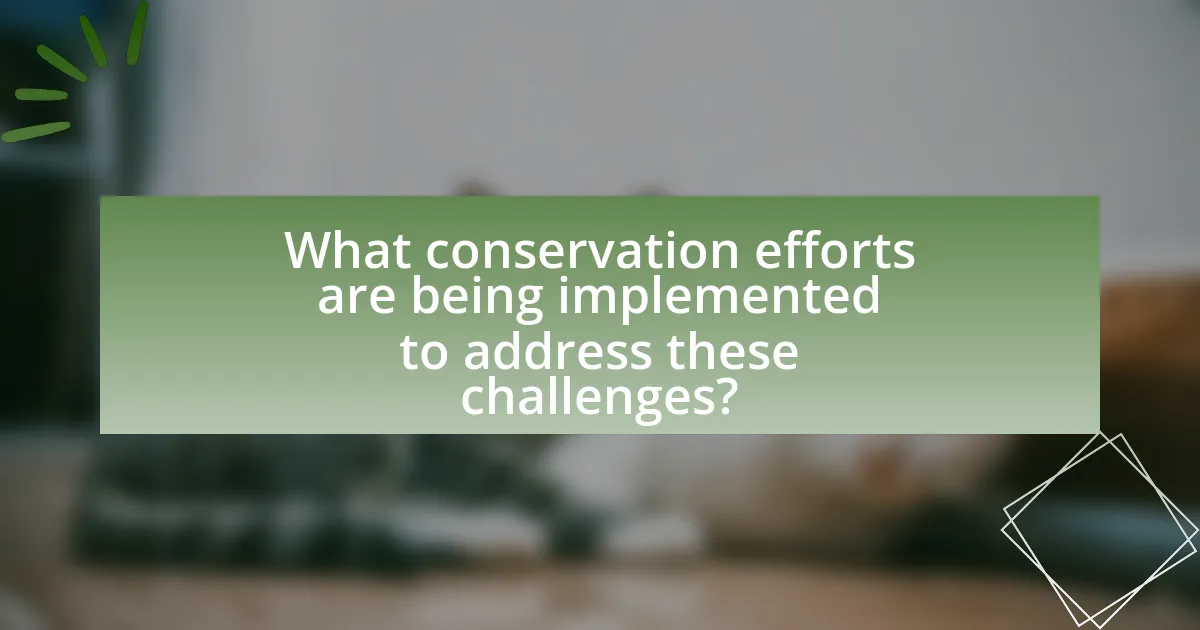
What conservation efforts are being implemented to address these challenges?
Conservation efforts addressing the challenges posed by climate change on wildlife migration patterns include habitat restoration, the establishment of wildlife corridors, and adaptive management strategies. Habitat restoration focuses on rehabilitating ecosystems that have been degraded, ensuring that migratory species have access to suitable environments. The establishment of wildlife corridors facilitates safe passage for animals between fragmented habitats, allowing them to migrate in response to changing climate conditions. Adaptive management strategies involve monitoring wildlife populations and adjusting conservation practices based on observed changes in migration patterns, ensuring that efforts remain effective as conditions evolve. These approaches are supported by research indicating that interconnected habitats and proactive management can significantly enhance the resilience of wildlife to climate change impacts.
How are conservation strategies adapting to changing migration patterns?
Conservation strategies are adapting to changing migration patterns by implementing dynamic management approaches that account for shifts in species distribution due to climate change. For instance, organizations are utilizing real-time data and predictive modeling to identify new migratory routes and critical habitats, allowing for timely interventions. A study published in the journal “Ecological Applications” highlights that adaptive management frameworks, which incorporate ongoing monitoring and stakeholder engagement, are essential for responding to these changes effectively. This approach ensures that conservation efforts remain relevant and effective in the face of evolving ecological conditions.
What role do protected areas play in supporting migratory species?
Protected areas play a crucial role in supporting migratory species by providing essential habitats that facilitate their movement and breeding. These designated regions offer safe corridors and stopover sites where migratory species can rest, feed, and reproduce without the pressures of habitat loss and human disturbance. For instance, the establishment of protected areas has been shown to significantly enhance the survival rates of migratory birds, as evidenced by studies indicating that populations of species like the Arctic Tern have stabilized in regions with robust conservation measures. Furthermore, protected areas help mitigate the impacts of climate change by preserving critical ecosystems that serve as buffers against environmental changes, thus ensuring that migratory routes remain viable.
How can technology assist in monitoring wildlife migrations?
Technology assists in monitoring wildlife migrations through the use of GPS tracking, remote sensing, and data analytics. GPS collars and tags provide real-time location data, allowing researchers to track animal movements over vast distances. Remote sensing technologies, such as satellite imagery, enable the observation of habitat changes and migration routes, while data analytics tools process large datasets to identify patterns and trends in migration behavior. For instance, a study published in the journal “Ecology Letters” demonstrated that GPS tracking of migratory birds revealed shifts in migration timing due to climate change, highlighting the effectiveness of technology in understanding wildlife responses to environmental changes.
What collaborative efforts are necessary for effective conservation?
Effective conservation requires collaborative efforts among governments, non-governmental organizations, local communities, and scientists. These stakeholders must work together to create and implement conservation strategies that address the impacts of climate change on wildlife migration patterns. For instance, the establishment of protected areas often necessitates input from local communities to ensure sustainable land use while also considering scientific data on species movement and habitat needs. Collaborative initiatives, such as the Global Climate Change Alliance, demonstrate how partnerships can enhance adaptive management practices and facilitate knowledge sharing, ultimately leading to more effective conservation outcomes.
How can international policies support wildlife migration conservation?
International policies can support wildlife migration conservation by establishing protected areas and corridors that facilitate safe passage for migratory species. These policies can enforce regulations that limit habitat destruction and promote sustainable land use practices, which are crucial as climate change alters migration patterns. For instance, the Convention on Biological Diversity encourages countries to create and manage protected areas, which can help maintain critical habitats for migratory species. Additionally, international agreements like the Ramsar Convention on Wetlands emphasize the importance of conserving wetland ecosystems that serve as vital stopover points for migratory birds. Such frameworks provide a collaborative approach to address the challenges posed by climate change, ensuring that migratory routes remain viable and ecosystems are preserved.
What community-based initiatives are proving successful in conservation efforts?
Community-based initiatives such as community-managed marine areas (CMMAs) and participatory forest management (PFM) are proving successful in conservation efforts. CMMAs empower local communities to manage marine resources sustainably, leading to increased fish populations and biodiversity, as evidenced by a study in the Philippines showing a 30% increase in fish biomass within five years of implementation. Similarly, PFM in Tanzania has resulted in improved forest cover and enhanced livelihoods for local communities, with data indicating a 20% increase in forest area over a decade. These initiatives demonstrate that involving local populations in conservation leads to more effective and sustainable outcomes.
What practical steps can individuals take to support wildlife migration conservation?
Individuals can support wildlife migration conservation by creating wildlife corridors and advocating for their protection. Wildlife corridors are essential pathways that allow animals to move safely between habitats, which is increasingly important due to climate change altering migration patterns. Research indicates that fragmented habitats can lead to population declines; for instance, a study published in the journal “Ecological Applications” highlights that connectivity between habitats significantly enhances species survival rates. Additionally, individuals can participate in local conservation efforts, such as tree planting and habitat restoration projects, which directly contribute to maintaining the ecosystems that support migratory species. Engaging in community awareness programs also helps educate others about the importance of wildlife migration and the impacts of climate change, fostering a collective effort towards conservation.
